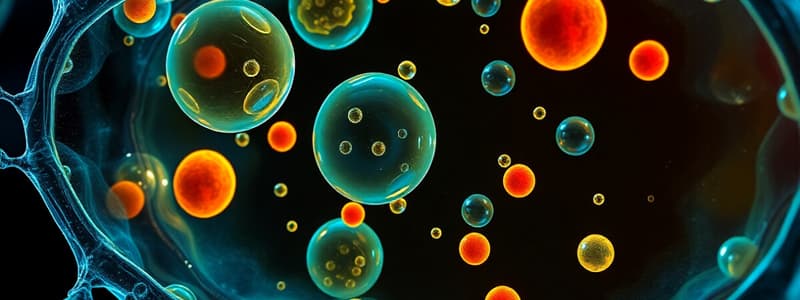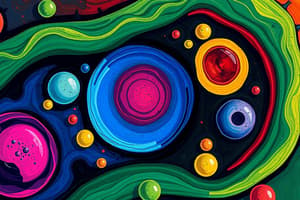Podcast
Questions and Answers
किस अंग का मुख्य कार्य ऊर्जा उत्पादन है?
किस अंग का मुख्य कार्य ऊर्जा उत्पादन है?
- गॉल्जी अप्पारेटस
- माइटोकॉंड्रिया (correct)
- नाभिक
- राइबोसोम
प्रोकैरियोटिक कोशिकाएं किसका अभाव करती हैं?
प्रोकैरियोटिक कोशिकाएं किसका अभाव करती हैं?
- माइटोकॉंड्रिया
- क्लोरोप्लास्ट
- आवरण
- नाभिक (correct)
कोशिका सिद्धांत के अनुसार, सभी कोशिकाएं किससे उत्पन्न होती हैं?
कोशिका सिद्धांत के अनुसार, सभी कोशिकाएं किससे उत्पन्न होती हैं?
- विकास
- गठने की प्रक्रिया
- पुनर्नवीनीकरण
- विभाजन (correct)
किस अंग के पास अपनी खुद की DNA होती है?
किस अंग के पास अपनी खुद की DNA होती है?
कोशिका का कौन सा कार्य वातावरण के परिवर्तनों का जवाब देना है?
कोशिका का कौन सा कार्य वातावरण के परिवर्तनों का जवाब देना है?
अंतःकक्षिका रेटिकुलम का कौन सा प्रकार लिपिड संश्लेषण में शामिल होता है?
अंतःकक्षिका रेटिकुलम का कौन सा प्रकार लिपिड संश्लेषण में शामिल होता है?
कोशिकाओं का कौन सा कार्य जीवों की वृद्धि और विकास के लिए महत्वपूर्ण है?
कोशिकाओं का कौन सा कार्य जीवों की वृद्धि और विकास के लिए महत्वपूर्ण है?
कोशिका का झिल्ली किस प्रकार की संरचना से बनी होती है?
कोशिका का झिल्ली किस प्रकार की संरचना से बनी होती है?
लिसोज़ोम का मुख्य कार्य क्या है?
लिसोज़ोम का मुख्य कार्य क्या है?
Flashcards are hidden until you start studying
Study Notes
Cell Structure
- Basic Unit of Life: Cells are the smallest structural and functional units of living organisms.
- Types of Cells:
- Prokaryotic: Lacks a nucleus (e.g., bacteria).
- Eukaryotic: Contains a nucleus and membrane-bound organelles (e.g., plants, animals).
- Cell Membrane:
- Phospholipid bilayer that regulates entry and exit of substances.
- Contains proteins for transport, signaling, and structural support.
Cell Organelles
- Nucleus:
- Control center of the cell, contains genetic material (DNA).
- Surrounded by a nuclear envelope.
- Mitochondria:
- Powerhouse of the cell, site of ATP (energy) production.
- Contains its own DNA and double membrane.
- Ribosomes:
- Sites of protein synthesis; can be free in the cytoplasm or attached to the endoplasmic reticulum.
- Endoplasmic Reticulum (ER):
- Rough ER: Studded with ribosomes; involved in protein synthesis and processing.
- Smooth ER: Lacks ribosomes; involved in lipid synthesis and detoxification.
- Golgi Apparatus:
- Modifies, sorts, and packages proteins and lipids for secretion or use within the cell.
- Lysosomes:
- Contains digestive enzymes to break down waste materials and cellular debris.
- Chloroplasts (in plants):
- Sites of photosynthesis; contain chlorophyll and have a double membrane.
Cell Theory
- Tenets of Cell Theory:
- All living organisms are composed of one or more cells.
- The cell is the basic unit of life.
- All cells arise from pre-existing cells through division.
- Significance: Provides a framework for understanding the structure and function of living organisms.
Cell Functions
- Metabolism:
- Cellular processes that convert food into energy, including cellular respiration.
- Growth and Development:
- Cells divide and differentiate to form tissues and organs.
- Reproduction:
- Cells can reproduce through processes such as mitosis (somatic cells) and meiosis (gametes).
- Homeostasis:
- Cells maintain a stable internal environment despite external changes.
- Response to Stimuli:
- Cells can respond to environmental changes and signals through receptors and signaling pathways.
कोशिका संरचना
- जीवन की मूल इकाई: कोशिकाएँ जीवित जीवों की सबसे छोटी संरचनात्मक और कार्यात्मक इकाइयाँ होती हैं।
- कोशिकाओं के प्रकार:
- प्रोकैरियोटिक: इनमें नाभिक नहीं होता (जैसे बैक्टीरिया)।
- युकैरियोटिक: इनमें नाभिक और झिल्ली से बंधे अंग होते हैं (जैसे पौधे, जानवर)।
- कोशिका झिल्ली:
- फॉस्फोलिपिड बाइलायर होती है, जो पदार्थों के प्रवेश और निकासी को नियंत्रित करती है।
- इसमें परिवहन, सिग्नलिंग और संरचनात्मक समर्थन के लिए प्रोटीन होते हैं।
कोशिका अंग
- नाभिक:
- कोशिका का नियंत्रण केंद्र, जिसमें आनुवंशिक सामग्री (DNA) होती है।
- नाभिकीय आवरण द्वारा घिरा होता है।
- माइटोकॉन्ड्रिया:
- कोशिका की ऊर्जा उत्पन्न करने वाली इकाई, ATP उत्पादन का स्थल।
- इसमें अपना DNA और दोहरी झिल्ली होती है।
- राइबोसोम:
- प्रोटीन संश्लेषण का स्थल; यह साइटोप्लाज्म में स्वतंत्र हो सकते हैं या एंडोप्लास्मिक रेटीकुलम से जुड़े हो सकते हैं।
- एंडोप्लास्मिक रेटीकुलम (ER):
- रफ ER: राइबोसोम से ढका हुआ है; प्रोटीन संश्लेषण और प्रसंस्करण में शामिल।
- स्मूथ ER: राइबोसोम नहीं होते; लिपिड संश्लेषण और विषमुक्ति में शामिल।
- गोल्ज़ी एपेरातस:
- प्रोटीन और लिपिड को संशोधित, क्रमबद्ध और पैक करता है, ताकि उन्हें स्रावित किया जा सके या कोशिका के भीतर उपयोग किया जा सके।
- लाइसोज़ोम:
- अपशिष्ट सामग्री और कोशिकीय मलबे को तोड़ने के लिए पाचन एंजाइमों को समायोजित करता है।
- क्लोरोप्लास्ट (पौधों में):
- प्रकाश संश्लेषण के स्थलों के रूप में कार्य करता है; इसमें क्लोरोफिल होता है और इसकी दोहरी झिल्ली होती है।
कोशिका सिद्धांत
- कोशिका सिद्धांत के नियम:
- सभी जीवित जीव एक या एक से अधिक कोशिकाओं से मिलकर बने हैं।
- कोशिका जीवन की मूल इकाई है।
- सभी कोशिकाएँ पूर्ववर्ती कोशिकाओं से विभाजन के माध्यम से उत्पन्न होती हैं।
- महत्व:
- यह जीवों की संरचना और कार्य को समझने के लिए एक ढाँचा प्रदान करता है।
कोशिका के कार्य
- उपापचय:
- खाद्य पदार्थों को ऊर्जा में बदलने की कोशिकीय प्रक्रियाएँ, जिनमें सेलुलर श्वसन शामिल है।
- विकास और विकास:
- कोशिकाएँ विभाजित और विभेदित होती हैं ताकि ऊतकों और अंगों का निर्माण हो सके।
- प्रजनन:
- कोशिकाएँ माइटोसिस (सोमैटिक कोशिकाएँ) और मायोसिस (गैमीट) जैसी प्रक्रियाओं के माध्यम से प्रज Brandenburg हिट कर सकती हैं।
- होमियोस्टेसिस:
- कोशिकाएँ बाहरी परिवर्तनों के बावजूद एक स्थिर आंतरिक वातावरण बनाए रखती हैं।
- उत्तेजनाओं का उत्तर देना:
- कोशिकाएँ रिसेप्टर्स और सिग्नलिंग पथों के माध्यम से पर्यावरणीय परिवर्तनों और संकेतों का उत्तर दे सकती हैं।
Studying That Suits You
Use AI to generate personalized quizzes and flashcards to suit your learning preferences.




